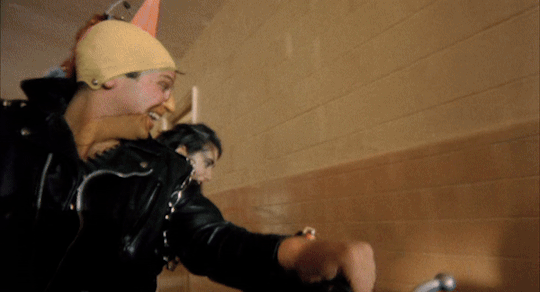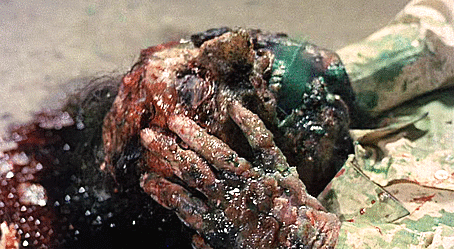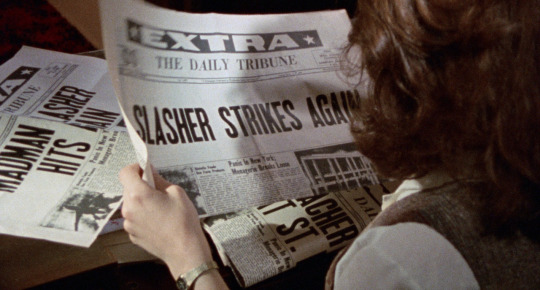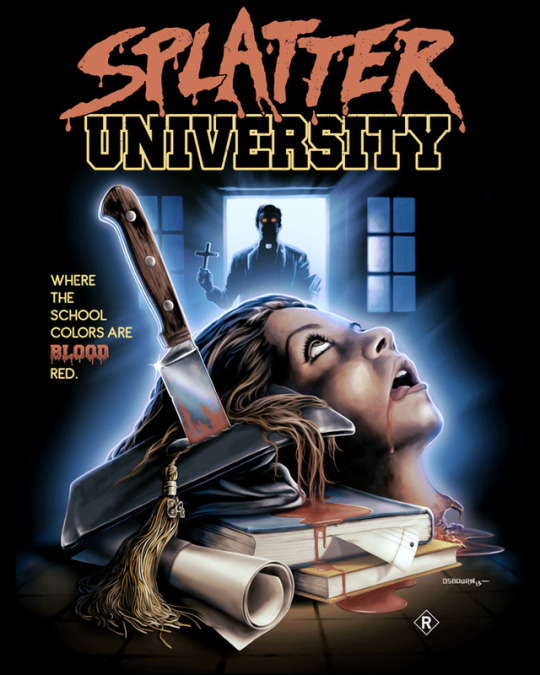#richard w. haines
Text




Class of Nuke 'Em High (1986) directed by Richard W. Haines and Lloyd Kaufman
Why don't you make like a hockey stick, and puck off!
#80s#gifs#the gifs of ghoulbones#gif#animated gifs#horror movies#1980s#class of nuke 'em high#richard w. haines#lloyd kaufman#1986#cult movies#troma films#troma entertainment#troma#horror comedy#trash aesthetic#rick howard#spud#muffey#Théo Cohan
18 notes
·
View notes
Text
On May 11, 1986 Class of Nuke 'Em High premiered at the Cannes Film Market.


#class of nuke 'em high#richard w. haines#lloyd kaufman#troma films#tromaville#troma entertainment#troma#troma film#dystopian sci fi#dystopian science fiction#dystopian film#splatterpunk#splatter movie#splatter movies#teensploitation movies#teensploitation#80s comedy movies#comedy movies#cult classic#cult movies#cult film#stoner movies#stoner art#stoner movie#movie art#art#drawing#movie history#pop art#modern art
3 notes
·
View notes
Text
My Top 5 Troma Movies
My Top 5 Troma Movies
#Cinema #FilmReview #MovieReview
Troma Entertainment is a film production company known for its low-budget, independent, and often controversial movies. Here are five of my favourite Troma movies, in no particular order:
The Toxic Avenger (1984)
Directed By – Michael Herz & Lloyd Kaufman
Starring – Mitch Cohen, Mark Torgl, Andree Maranda, Pat Ryan Jr
This movie tells the story of a scrawny, bullied janitor who becomes a…

View On WordPress
#Allyson Sereboff#Andree Maranda#Bill Weeden#Class of Nuke &039;Em High#Gabriel Friedman#Gil Brenton#Jane Jensen#Janelle Brady#Jason Yachanin#Kate Graham#Lloyd Kaufman#Mark Torgl#Maximillian Shaun#Michael Herz#Mitch Cohen#Op-Ed#Op-Eds#Pat Ryan#Pat Ryan Jr#Richard W. Haines#Rick Gianasi#Robert Prichard#Robin Watkins#Susan Byun#The Toxic Avenger#Thomas Cmkovich#Troma#Valentine Miele#Will Keenan
1 note
·
View note
Photo

Class of Nuke ‘Em High (1986)
Dir. By Lloyd Kaufman (Samuel Weil) & Richard W. Haines
#Class of Nuke 'Em High#Nuke 'Em High#Tromaville#Troma Entertainment#Llyod Kaufman#Richard W Haines#Michael Herz
32 notes
·
View notes
Text
The Mystery of the Mary Celeste

May 11, 2023
The Mary Celeste ship was built in Spencer’s Island, Nova Scotia and was launched under British registration as Amazon on May 18, 1861. On the registration documents the ship was 99.3 feet long, 25.5 feet broad, with a depth of 11.7 feet.
She had previously been in a wreck in Cape Breton and was very damaged. In November 1868, a man named Richard W. Haines, from New York paid $1,750 (US) for the wrecked ship and spent $8,825 to restore it. In December 1868, the ship was registered to the Collector of the Port of New York as an American vessel under the name, Mary Celeste. Haines also became the captain of her.
In October 1869, the ship was seized from Haines and sold to a New York consortium. For at least three years there is no record of Mary Celeste’s trading activities. In 1872, she underwent a refit that cost $10,000 and her size was increased, and the new captain’s name was Benjamin Spooner Briggs.
In October 1872, Briggs, his wife, and infant daughter took Mary Celeste on her first voyage, after her New York refit, to Genoa, Italy. Briggs had left his school aged son behind to be taken care of by his grandmother.
Briggs chose the crew for the voyage himself, including first mate Albert G. Richardson, second mate Andrew Gilling, 25 years old, the steward was Edward William Head, and four seamen who were German from the Frisian Islands: brothers Volkert and Boz Lorenzen, Arian Martens, and Gottlieb Goudschaal. Briggs and his wife were extremely satisfied with the crew.
On October 20, 1872, Briggs went to Pier 50 on the East River in New York City to supervise the ship loading 1,701 barrels of alcohol. Briggs’ wife and infant joined him a week later.
On Tuesday, November 5, 1872, Mary Celeste left Pier 50 and went into New York Harbor. The weather was uncertain, so they waited for better conditions. After two days, the weather was good enough to begin the voyage, and so Mary Celeste sailed into the Atlantic.
A Canadian ship, Dei Gratia was nearby in Hoboken, New Jersey, waiting on cargo before they set sail. The Captain, David Morehouse, and first mate Oliver Deveau were Nova Scotians who were highly experienced. It was even rumoured that Captain Morehouse and Briggs were friends and had dined together the night before Mary Celeste departed, however the evidence of this comes from Morehouses’ widow 50 years after the event.
Dei Gratia departed for Gibraltar on November 15, 1872, following the same route as Mary Celeste had seven days earlier.
On December 4, 1872, between the Azores and the coast of Portugal, Captain Morehouse on the Dei Gratia was made aware that there was a vessel heading unsteadily towards them about 6 miles away. The ship appeared to be making erratic movements, leading Morehouse to believe something must be wrong.
Captain Morehouse noticed there was nobody on deck when the ship came closer, and they were receiving no replies from their signals. Captain Morehouse sent Deveau and his second mate John Wright in a boat to investigate the strange vessel.
The two men discovered that this vessel was indeed the Mary Celeste, as the name was on her stern, so they climbed onto the ship and found that it had been completely deserted; there was not one person around. The sails were partly set and in poor condition, some were completely missing and a lot of the rigging had been damaged, with ropes hanging over the sides. The ship had a single lifeboat that was missing. The binnacle that had the ship’s compass in it was out of place and the glass cover was broken.
There was 3.5 feet of water in the hold, however that was not suspicious for a ship of that size. A makeshift sounding rod which measures the water in the hold was found abandoned on the deck.
The Mary Celestes’ daily log was in the mate’s cabin, and the final entry date had been at 8 am on November 25, nine days before the ship was discovered. The position was recorded to be about 400 nautical miles from the point where Dei Gratia had found her.
Deveau reported that the inside of the cabin had been wet and untidy from water that had come in through doorways and skylights, however it was mostly in order. There were personal items scattered in Captain Briggs’ cabin, however most of the ship’s papers were missing, along with navigational instruments.
There was no obvious signs of fire or violence, and there was no food prepared or being prepared. It appeared that there had been an orderly departure from the Mary Celeste, the crew using the missing lifeboat.
Captain Morehouse decided to bring Mary Celeste to Gibraltar, which was 600 nautical miles away. Under maritime law, a salvor could get a decent amount of money of a rescued vessel and cargo.
Morehouse divided his crew, and sent 3 members on the Mary Celeste, which he and four other members stayed on the Dei Gratia; however this meant that each ship was very under crewed. Dei Gratia arrived at Gibraltar on December 12, while Mary Celeste arrived the next day due to fog.
The salvage court hearings began on December 17, 1872, Captain Morehouse had written to his wife that he believed he would be paid well for the Mary Celeste salvage. Testimony from Deveau and Wright convinced the court that a crime had been committed, foul play was involved.
On December 23, 1872, there was an examination of Mary Celeste, which reported that there were cuts on each side of the bow, caused by what they thought a sharp instrument. There was also what appeared to be possible traces of blood on Captain Briggs’ sword.
The report stated that the ship did not appear to have been struck by heavy weather, or been involved in a collision. A group of Royal Naval captains also examined the ship and said the cuts on the bow seemed to be caused deliberately. There was also stains on one of the ship’s rails that might have been blood, with a deep mark possibly caused by an axe.
On January 22, 1873, the reports from the court hearings were sent to the Board of Trade in London, with Frederick Solly-Flood, the Attorney General of Gibraltar concluded that the crew on the Dei Gratia had wanted to steal the alcohol on the Mary Celeste, and murdered Captain Briggs’ and his crew in a drunken frenzy. Flood believed that Captain Morehouse and his men were hiding something, that the daily log of where the Mary Celeste had been had been doctored. Flood did not believe that the ship could have travelled 400 nautical miles while being uncrewed.
It was discovered that what appeared to be “blood stains” were in fact not blood, which setback Flood’s theory of murder. Another blow was when Captain Shufeldt of the US Navy reported the marks on the bow were not man-made, but came from natural actions of the sea.
There was nothing concrete, so Flood had to release the Mary Celeste from the court’s jurisdiction on February 25, 1873. The salvage payment was decided on April 8, 1873, the award was about one-fifth of the total value of ship and cargo, far lower than what was expected.
While Flood’s theories of murder were not very convincing, there was still suspicion that the ship had met foul play of some sort. Some believed that Briggs and Morehouse were involved together, wanting the money, but it doesn’t make sense that they would have planned such an attention drawing event. Others also comment that if Briggs wanted to disappear permanently he wouldn’t of left his young son behind with his mother.
Some believed the Mary Celeste was attacked by Riffian pirates who were active off the coast of Morocco in the 1870′s, however this has been largely dismissed because pirates would have looted the ship, yet the captain’s personal possessions were found; some which had significant value.
A New York insurance appraiser named Arthur N. Putman, was a leading investigator in sea mysteries in the early 20th century. He proposed a lifeboat theory, stating that only one single lifeboat had been missing, the rope had been cut, not untied, which meant that when the Mary Celeste was abandoned, it happened very quickly.
There was multiple times in the ship’s logs where it was mentioned there was ominous rumbling and small explosions from the hold. Putman believed that the alcohol on ship gave off explosive gas and one day there was a more intense explosion of this. A sailor perhaps went below deck with a light or a lit cigar which set off fumes causing an explosion that was violent enough to blow off the top covering on the hatch, explaining why it was found in an unusual position. Putman believes Briggs and the crew were in a panic and piled into one lifeboat, abandoning Mary Celeste.
Deveau, who was one of the men who examined the abandoned ship on sea, proposed that Briggs abandoned the ship after false sounding, there might of been a malfunction of the pumps or another mishap, giving the impression the ship was taking on water at a rapid pace, the crew might have assumed the ship was in danger of sinking.
Mary Celeste made her way to Genoa, and then left on June 26, 1873. She arrived in New York on September 19, 1873. Due to the Gibraltar hearings and newspaper stories she became quite unpopular, nobody wanted her. In February 1874, Mary Celeste was sold at a considerable loss to a partnership of New York businessmen.
Mary Celeste sailed mainly in the West Indian and Indian Ocean routes, but was losing a lot of money. In February 1879, her captain was a man named Edgar Tuthill, who had fallen ill. Tuthill died and some believed the ship was cursed, as he was the third captain who had died prematurely.
In August 1884, a new captain named Gilman C. Parker took on the ship. On January 3, 1885, Mary Celeste approached a large coral reef, the Rochelois Bank, where she purposely ran into it, ripping out the bottom and wrecking her beyond repair. The crew then rowed themselves ashore, and sold what was left of the cargo for $500.
In July 1885, Parker and his shippers were tried in Boston for conspiracy to commit insurance fraud, with Parker also being charged with “wilfully casting away the ship” which was known as barratry, which you could be sentenced to death for.
On August 15, 1885, the jury could not agree on a verdict. Instead of having another trial, which cost a lot of money, the judge negotiated an arrangement where Parker and his crew withdrew their insurance claims and repaid what they got. The barratry charge was deferred and Parker was set free, though his reputation was ruined.
Parker died in poverty three months later, one of the co-defendants went mad and another ended his life. This further caused people to believe Mary Celeste was cursed.
At Spencer’s Island, Mary Celeste and her lost crew are commemorated by a monument, and by a memorial outdoor cinema built in the shape of the vessel’s hull. The fate of the crew of the Mary Celeste have never been discovered, and over 150 years later, it is unlikely we will ever discover the truth.
#mystery#unsolved#UNSOLVED MYSTERIES#unsolved crime#unsolved case#ship#vessel#true crime#Crime#sail#mary#celeste
20 notes
·
View notes
Text

Class of Nuke 'Em High, also known as Atomic High School, is a 1986 American science fiction comedy horror film made by cult classic B-movie production group Troma Entertainment. It was directed by Richard W. Haines and Lloyd Kaufman under the pseudonym Samuel Weil. New York holographer Jason Sapan created the laser effects.
#b film#b movie#class of nuke 'em high#1986#80s films#80s movies#80s punk#80s punk fashion#mutants#troma entertainment#tromaville#troma#troma films#lloyd kaufman#michael herz#film poster#movie poster#film poster art#movie poster art#nuclear#nuclear power#nuclear power plant#nuclear waste#sci fi#horror#comedy#atomic high school#the cretins
3 notes
·
View notes
Text

Class of Nuke 'Em High (Lloyd Kaufman, Michael Herz, Richard W. Haines, 1986)
0 notes
Video
youtube
THE MOST DANGEROUS PLACE TO WATCH A MOVIE! | 42nd Street Memories | Documentary Review
This is my review for the documentary "42nd Street Memories: The Rise And Fall Of America's Most Notorious Street".
Released in 2015 and directed by Calum Waddell, it's about New York's 42nd Street, located between 7th and 8th Avenue in Midtown Manhattan, where rows of movie theaters across the street from each other offered screening of all the sleazy grindhouse and horror movies you enjoyed from that era.
Until the early 90's when it got shutdown and got Disneyfied and sanitized for your unpleasure.
You'll hear actors, directors, film distributors, producers, authors, film historians talking about their first hand experiences going to see movies on 42nd Street known also as "The Deuce".
People like Frank Hennenlotter, Richard W. Haines, Joe Dante, Larry Cohen, Matt Cimber, Veronica Hart, Debby Rochon, William Lustig, Buddy Giovinazzo, Tom Holland, Lloyd Kaufman, Greydon Clark and Jeff Lieberman.
You can watch it for free on Tubi:
https://tubitv.com/movies/616810/42nd-street-memories
Or get it on Blu-ray from the Grindhouse Releasing of "Pieces":
https://shop.grindhousereleasing.com/collections/pieces
My Movie Trailers Compilation Collection Video:
https://www.youtube.com/watch?v=d6YbegE2NuU
Petter Wellers And Sam Elliott Hanging Out on 42nd Street:
https://www.youtube.com/watch?v=jG0US4BQx5Y
My 42nd Street Shirt can be purchased here:
https://www.etsy.com/ca/listing/895758784/vintage-new-york-42nd-street-enjoy-a
PLEASE LIKE! SHARE! & SUBSCRIBE!
Merch Store :
https://www.etsy.com/shop/GrindhouseFunhouse
• INSTAGRAM: https://www.instagram.com/grindhousefunhouse
• FACEBOOK: https://www.facebook.com/grindhousefunhouse
• TWITTER: https://www.twitter.com/grindfunhouse
• REDDIT: https://www.reddit.com/r/grindhousefunhouse
1 note
·
View note
Photo



Class of Nuke 'Em High (1986)
#class of nuke 'em high#horroredit#lloyd kaufman#richard w. haines#troma entertainment#80s horror#gore#filmedit#Horror Movies#horror#80s
743 notes
·
View notes
Photo


#Class of Nuke 'Em High#Richard W. Haines#Lloyd Kaufman#Samuel Weil#Mark Rudnitsky#Stuart Strutin#Graham Flashner#Troma#80s
70 notes
·
View notes
Text
Toys & Interview w/ Richard W. Haines
Toys & Interview w/ Richard W. Haines
Maybe it’s a horror movie continues! This week, we are doing Toys, starring the late and great, Robin Williams.
This inexcusably unsettling movie was a 10-year passion project by writer/ director, Barry Levinson (and then wife, Valerie Cutrin). It is inarguably polarizing, because while it was nominated for a Razzie for worst director, it also received Oscar nominations for Art Direction and…

View On WordPress
1 note
·
View note
Photo

Splatter University | Richard W. Haines | 1984
105 notes
·
View notes
Text
On June 3, 1987 Class of Nuke 'Em High was screened at the Night Visions Film Festival.


#class of nuke 'em high#richard w. haines#troma film#troma entertainment#tromaville#troma films#splatter movies#splatterpunk#splatter comedy#splatter film#80s comedy movies#movie art#art#drawing#movie history#pop art#modern art#pop surrealism#cult movies#portrait#cult film
7 notes
·
View notes
Photo

Splatter University's original motion picture soundtrack is available on vinyl for $27 via Terror Vision Records. Composed by Chris Burke (Blue Vengeance), the score was pulled from the original tapes and remastered.
The album is pressed on 180-gram vinyl with two color variants: blood-splatter and black. It's housed in gatefold packaging with liner notes by Burke and director Richard W. Haines. A digital download is included.
A cassette version, limited to 100, is also available for $8, along with a new edition of the film on VHS, limited to 50, for $20.

#splatter university#soundtrack#horror#80s horror#1980s horror#slasher#terror vision records#vinyl#gift#vhs#troma#troma entertainment#vinegar syndrome#earl kessler jr.#cassettes#richard w. haines
10 notes
·
View notes
Text

📼📼📼 Class Of Nuke ‘Em High - 1986 - Lloyd Laufman & Michael Herz & Richard W. Haines 📼📼📼
#class of nuke ‘em high#troma#lloyd kaufman#michael herz#richard w. haines#vhs#vhs horror#horror#horror collection#horror movie#vhs collector#horror collector#sfx#cult#gore#nerdstuff#analog#collector#recorder#vhs aesthetic#vhs cover#vhs tapes
54 notes
·
View notes
Photo

#1068
Splatter University - Richard W. Haines 1984
5 notes
·
View notes